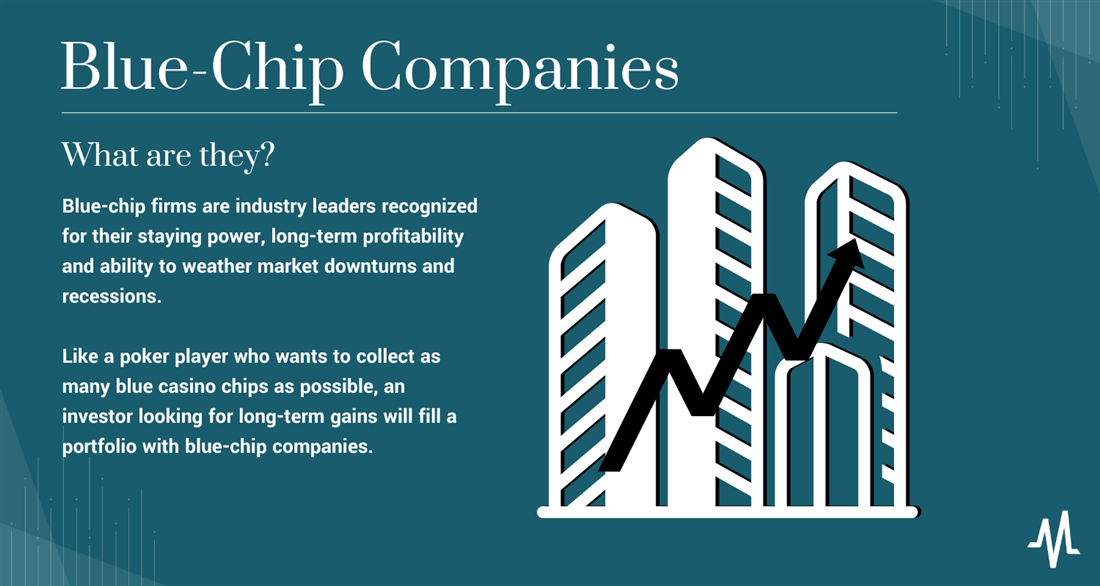What is a blue chip company? When an asset is valuable and highly sought after, it might earn the term "blue chip." Consumers can label anything a blue chip, such as a painting from a renowned artist or a college football prospect with tremendous physical gifts.
A blue-chip stock returns dividends, which is why many of the largest and most successful public companies also carry the moniker "blue chips."
Overview of Blue-Chip Companies
So, what are blue chips, anyway? If you've ever played table games like poker or blackjack at a casino, you likely noticed the different colors assigned to chips. Traditionally, white and red casino chips are the most common and carry the lowest values. On the other hand, blue is the color casinos most frequently reserve for their highest-value chips, so the term floated into popular culture to describe assets of the highest value and quality.
The term "blue-chip stocks" entered market vocabulary in the 1920s thanks to investment writer Oliver Gingold, who worked at the predecessor to the Dow Jones company.
Like a poker player who wants to collect as many blue casino chips as possible, an investor looking for long-term gains will fill a portfolio with blue-chip companies. Blue chip firms are industry leaders recognized for their staying power, long-term profitability and ability to weather market downturns and recessions. You're likely familiar with the Dow Jones Industrial Average (DJIA), the oldest of the three major indices used to track the performance of the U.S. stock market. Experts often call the DJIA the "blue-chip index" because it tracks a relatively small swath of the market but contains 30 large-cap blue-chip companies from various sectors and industries.

Characteristics of Blue-Chip Companies
Blue-chip firms can be found in different industries and fields, both domestically and abroad. But when most investors talk about blue-chip companies, they reference large-cap American stocks. While there are no rigid criteria on what makes a company a blue chip, they all share a few common characteristics:
- Large market cap: A blue-chip company doesn't necessarily need to be a $500 billion behemoth, but having a large market capitalization figure is essential for stability and accessibility. Small and mid-cap companies usually aren't considered blue chips; a market cap of $10 billion or more is a common cutoff point.
- Easy to trade: Liquidity is another common feature of blue-chip companies. Blue chip stocks should be easy to find and not have high bid/ask spreads. One of the main benefits for institutional investors is the ability to buy large blocks of stock without paying high transaction fees. Blue chips usually trade millions of shares daily.
- History of success: One of the reasons the Dow Jones remains a heavily-tracked index is its focus on blue-chip stocks. The stocks in the Dow are blue chips in the most robust sense, many of which have 50 or more years of business success. Blue chips tend to be older companies in less growth-focused industries, although this rule has plenty of exceptions.
- Low volatility: Beta is a metric that measures a stock's volatility compared to the volatility of the overall market. A low-beta company has weaker price gyrations than the market; blue-chip stocks frequently find themselves in this low-beta category. Low volatility can be a major perk for investors who want predictability in their stocks, but low volatility also tends to mean lower returns.
- Increasing dividend payouts: Not all blue-chip companies are dividend payers. A company like T-Mobile U.S. Inc. (NASDAQ: TMUS) meets all the standard criteria of a blue-chip stock but pays zero dividends. However, dividends are often a major component of blue-chip investing, and the companies that increase their dividends annually belong to a special group. For example, the Dividend Aristocrats are a group of large-cap companies in the S&P 500 that have raised their dividend payouts for 25 consecutive years.
Why Invest in Blue-Chip Companies?
Now that we've answered the question, "What are blue chip companies?", it shouldn't be too hard to understand why blue-chip investing is so popular. Raking in the highest possible gain isn't the goal for many investors. If you're young and will have plenty of time in the market, riskier investments like growth stocks or small caps make sense. These companies may have a higher risk of failure, but the rewards can be significant, and a long time horizon helps negate some risks.
Blue-chip companies don't have the promise of sky-high returns. After all, it's much easier for a small company to double its market cap than a large-cap Dow Jones component. But for retirees, institutions and other investors with a conservative slant, blue chips are a way to maintain market exposure and collect dividends without taking on too much risk. Blue chips have proven track records of capital preservation, which is why many investing strategies revolve around them.
Some common blue-chip investing techniques involve buying stocks near their 52-week lows or using dividend capture to reap the payouts without the exposure risk. But most blue-chip investors buy and hold these stocks for long periods, often decades or more. If you're looking for one of the more proven "set it and forget it" investment strategies, buying and holding blue-chip firms is a great place to start.
Examples of Blue-Chip Companies
You can find blue-chip companies in every sector of the market. Here are a few examples from differing industries:
- 3M Company Inc. (NYSE: MMM): 3M is a member of the Dividend Aristocrats, one of the select companies with 25-plus years of annual dividend payout increases. A member of the DJIA and S&P 500 indices, 3M has a market cap of $60 billion and operates in various industries. Most investors know 3M for its consumer products like adhesives, home improvement and first aid supplies. If you've ever tried to mount a picture frame on a wall, you've likely used a 3M product.
- UnitedHealth Group Inc. (NYSE: UNH): UnitedHealth Group is one of the largest companies in the entire world. Operating in hospitals, home care, government, life sciences and pharmacy services, UnitedHealth has its hands in many healthcare systems across the United States.
- Apple Inc. (NASDAQ: AAPL): Apple is a unique member of the DJIA. While indeed not the oldest member of the blue-chip index, it's now the largest by market cap and one of the most notable companies in the entire world. Apple isn't your typical blue chip — it pays a small dividend, shares many similarities with growth stocks and sells electronics and tech.
Alternatives to Blue-Chip Investing
Investing in blue-chip companies is typically a buy-and-hold strategy. Blue chips comprise most Americans' retirement portfolios, whether through direct equity, ETFs and mutual funds or target date funds. But blue-chip investing is a slow process meant to preserve capital and build wealth over time. If you have a high risk tolerance or short time horizons, you might want to consider some alternatives, such as:
- Day trading: Day trading means using technical indicators to buy and sell stocks in a single trading session. You hold no positions overnight, and gains are incremental.
- Swing trading: A combination of technical analysis, fundamentals and potential catalysts are employed to buy and sell stocks quickly. You may hold positions for several weeks or months or as short as a single night.
- Growth investing: The opposite of blue-chip stocks would be risky growth stocks, which offer the potential for high returns and the risk of substantial losses. Growth stocks tend to be smaller companies focused on the tech or pharmaceutical industries, but growth stocks can also be large companies like Alphabet Inc. (NASDAQ: GOOG) and Netflix Inc. (NASDAQ: NFLX).
Pros and Cons of Blue-Chip Investing
Investors deciding on whether to utilize a blue-chip strategy should weigh the following pros and cons before purchasing any shares:
Pros
First, the pros:
- Predictability: Blue-chip stocks have low volatility and usually provide consistent income through dividends. Investors like retirees on a fixed income need consistency and reliability, not market-smashing outperformance. Blue chips are some of the safest equities you can buy.
- Low risk of large losses: While blue chip bankruptcy isn't unheard of (think Lehman Brothers and Chrysler), it is rare. Companies like JPMorgan Chase & Co. (NYSE: JPM), Colgate-Palmolive Company (NYSE: CL) and Cigna Corporation (NYSE: CI) have been around for more than 200 years! These are stocks that many investors hold for life and then pass down to heirs.
- Range of industries and sectors: Every industry has leaders; you can find blue chips in all market corners. Investing in blue chips is an excellent way to build a diverse stock portfolio.
Cons
Now, the downsides:
- May underperform growth-oriented peers: Reliability is important, but investors looking for outperformance may prefer minimal exposure to blue chips, especially during bull markets that reward risk-taking.
- Dividends can be tax-inefficient: Be sure to understand the tax status of all your dividends, especially if holding these stocks in a taxable account. Some dividends are unqualified if certain holding periods aren't met and unqualified dividends are taxed at income level.
- Cannot eliminate risk: Blue chips might be safe compared to growth stocks, but no security can escape market risk, and even the best blue chips will lose value in a bear market. The goal of blue-chip investing isn't to prevent losses but to minimize them in a downturn.
Blue Chips: Safe but Possibly Unspectacular
Blue-chip stocks are a popular asset class amongst retirees, savers and institutional investors thanks to their reliability and staying power. Many blue chips can boast a century or more of successful business practice, and their stockholders receive steady gains.
But large dividend-paying companies aren't always the best choice for every investor. If you have a long time horizon or a strong risk tolerance, something other than blue-chip investing might fit your desired goals. However, check out MarketBeat's list of the best blue-chip stocks to protect capital while still earning market returns.
FAQs
Here are a few quick answers to common blue-chip investing questions:
What is the meaning of a blue-chip company?
Blue-chip companies are large, established firms with a history of consistent returns. Blue chips are safe and reliable investments compared to riskier growth stocks.
Are Amazon and Apple blue-chip companies?
Yes, Amazon and Apple are considered blue chips thanks to their size and history, despite coming from the traditionally riskier tech sector. Apple is one of the 30 companies in the Dow Jones Industrial Average.
Which companies are blue-chip companies?
Any company with a large market cap, long business history and sturdy balance sheet can be considered a blue chip company. Investors seek out blue chips for their security and low risk of failure.






